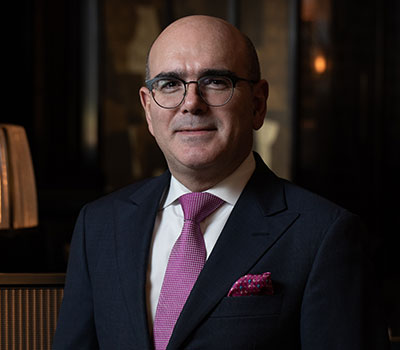Michel Couvreux grew up in Brittany, France, where he apprenticed to be a chef. At 15 years old, he was working at a bistro in Rennes, before switching to the front of the house after graduation. He discovered wine while working as a waiter. “In Brittany, my parents never had wine,” he says, recalling how he quickly became fascinated. Just as he turned 18, he started his apprentice as a sommelier at a one-star Michelin restaurant in Rennes. Couvreux’s career took him through several three-star restaurants in Paris, including L’Arpège and Guy Savoy, before he moved to NYC in 1993 to join the wine team at Bouley. By 2009, after stints at Le Bernardin and Cru, Couvreux landed as head sommelier at Per Se, chef Thomas Keller’s NYC outpost overlooking Central Park. When Keller and his team opened TAK Room in NY’s Hudson Yards, Couvreux became the beverage director, managing the list at both restaurants.


You offer a selection of 1,800 wines at Per Se, 750 at TAK Room. How do the lists differ?
At Per Se, we cover most all the world—France, US, Spain, Italy…also Germany, Austria, New Zealand. We have a large selection of half bottles and a lot of older vintage verticals. It’s a three-star Michelin thing. At TAK Room, we want to have a smaller selection, focused on mostly French and American wine, classic regions—Napa, Sonoma, Oregon, Burgundy, Rhône, Loire Valley. We have a little bit from Barolo and Tuscany, and from Spain—Rioja and Priorat. The focus is continental cuisine, so classic dishes like beef Wellington, sole meunière, roasted chicken. We don’t have white wine from Spain or Italy at TAK Room, just because it doesn’t necessarily fit the menu; it’s a fixed menu, always the same, every day. At Per Se, the tasting menu changes every day, so we need more selection to do wine pairings for the guests.
At Per Se, you shared that red makes up 50 percent of your wine sales; at TAK Room, it’s 80 percent. What’s behind that difference?
If you look the Per Se menu, it’s a nine-course tasting menu, from caviar to foie gras, two fish dishes, two meat dishes, then dessert. We sell white wine for the first part of that tasting menu.
At TAK Room, the menu is more meat-oriented: côte du boeuf, beef Wellington, lamb, veal…and only a couple of seafood dishes, so the menu is more red-wine oriented. The guests mostly want beef Wellington or steak or lamb or veal; red wine is more appropriate. Guests might start with a cocktail, maybe a glass of white, then move to red wine.
A Sonoma Valley cabernet at TAK Room, a Bordeaux at Per Se…
At TAK room, it’s an American restaurant, so a lot of people think of cabernet, quickly, and guests are very comfortable to go to a page, look at the price point they enjoy and just order. They don’t ask for a sommelier. At Per Se, our guests ask for the sommelier; they’ll ask for a recommendation. They may say, ‘We enjoy cabernet sauvignon and want to try something different.” And also, it’s a special night when you go to Per Se. At a classic fine dining restaurant, you have a white Burgundy and a red Bordeaux, maybe a glass of Champagne to start.
Cabernet sauvignon between $120 and $200, that’s what a lot of guests at TAK Room enjoy and appreciate. At Per Se, guests will go higher. It depends on the night—$300, $400—that’s where our guests are at Per Se. And you look at Bordeaux today, you have some great Bordeaux. You don’t need to think about first or second growths. You have third, fourth or fifth growths and you have older wines that are at a good price. You go to Burgundy, and it’s hard to find a great wine at a good price. In Burgundy, they only make a small quantity of wine; in Bordeaux it’s a lot of wine.
At Per Se, you note that 55 percent of the wine sold as pairings. Can you tell me about how you structure that program?
Per Se is tasting-menu only. So, often guests don’t want to make a choice; they know they will have a tasting menu, they just want the full experience. We have two sets of wine pairings. The sommeliers will look at the menu, and after the chef explains the dishes one of the sommeliers will come up with wine-pairing suggestions for the guests. After that, we work table by table; our sommeliers will have a conversation with each table to see if they have any preference. Sometimes we have guests coming from Europe who want to try wine from the United States. Or we have tables that want only red wine. We try to pair the wine with the food and to make sure the guests enjoy the wines they are drinking. As a sommelier, you might think this is the best pairing, but maybe the guest is not going to like your choice. Our goal is for the guest to enjoy the food as much as the wine.
Joshua Greene is the editor and publisher of Wine & Spirits magazine.
This is a W&S web exclusive. Get access to all of our feature stories by signing up today.
















